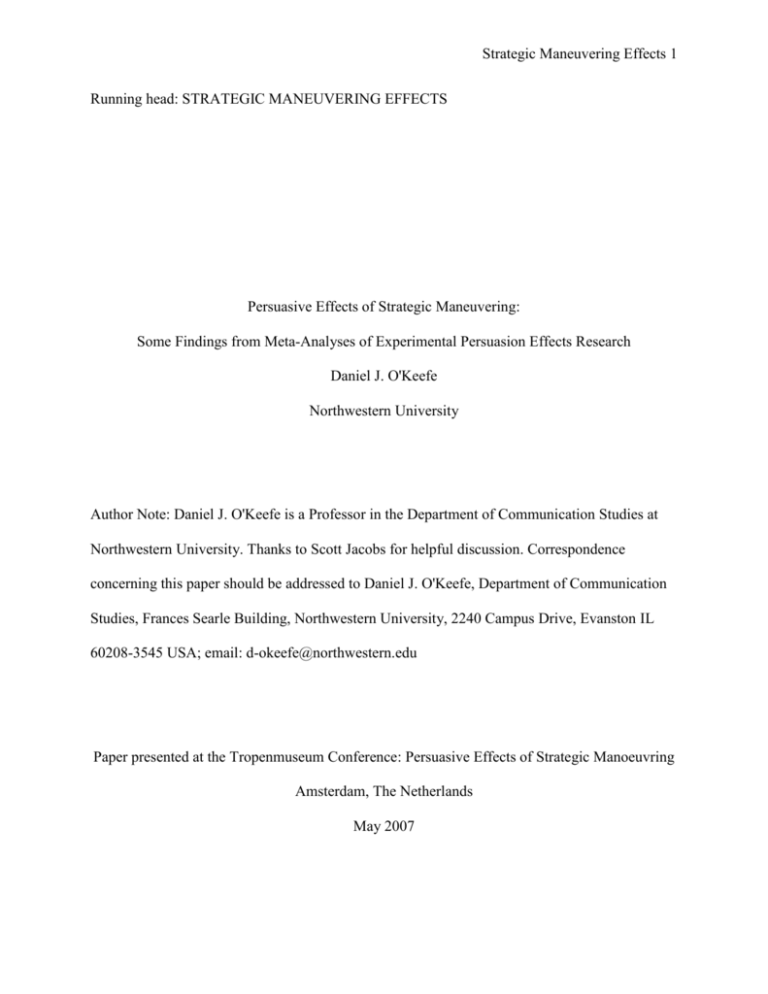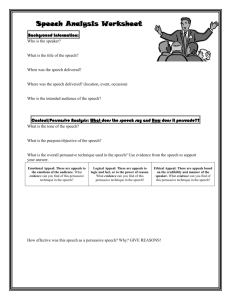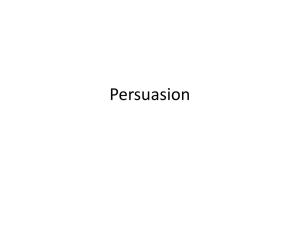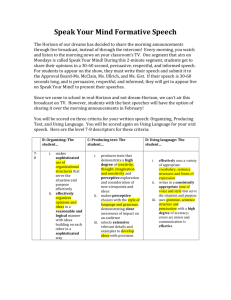Word document - Daniel J. O`Keefe home page
advertisement

Strategic Maneuvering Effects 1 Running head: STRATEGIC MANEUVERING EFFECTS Persuasive Effects of Strategic Maneuvering: Some Findings from Meta-Analyses of Experimental Persuasion Effects Research Daniel J. O'Keefe Northwestern University Author Note: Daniel J. O'Keefe is a Professor in the Department of Communication Studies at Northwestern University. Thanks to Scott Jacobs for helpful discussion. Correspondence concerning this paper should be addressed to Daniel J. O'Keefe, Department of Communication Studies, Frances Searle Building, Northwestern University, 2240 Campus Drive, Evanston IL 60208-3545 USA; email: d-okeefe@northwestern.edu Paper presented at the Tropenmuseum Conference: Persuasive Effects of Strategic Manoeuvring Amsterdam, The Netherlands May 2007 Strategic Maneuvering Effects 2 Abstract Meta-analyses of the persuasive effects associated with various strategic maneuvers are reviewed. Both maneuvers that involve alternative ways of presenting a given argument or set of arguments (e.g., gain-framed versus loss-framed appeals) and maneuvers that involve presenting different sets of substantive arguments (e.g., one-sided messages, which provide only supporting arguments, versus two-sided messages, which both present supporting arguments and discuss opposing arguments) are found to make relatively little difference to persuasiveness; across eight different maneuvers, the average effect size corresponds roughly to a correlation of .07. Thus although there is little reason to fear that superficial presentational variations will deeply affect persuasive success, there is similarly little reason to hope that substantive argumentative variation will have dramatic effects. Strategic Maneuvering Effects 3 Persuasive Effects of Strategic Maneuvering: Some Findings from Meta-Analyses of Experimental Persuasion Effects Research This conference’s subject—the persuasive effects of strategic maneuvering—naturally invites some discussion of what might be learned from the quite substantial empirical (especially experimental) research literature concerning factors influencing persuasive effects. Of course, the extant research on persuasive effects has not been conducted or reporting using the language of “strategic maneuvering,” so the place to start is by considering what’s to count as a strategic maneuver. Van Eemeren and Houtlosser (2001, p. 151) describe strategic maneuvering as advocates’ “attempt to make use of the opportunities available in the dialectical situation for steering the discourse rhetorically in the direction that serves their own interests best”—where their own interests are to be understood as, most fundamentally, having their views prevail. So presumably anything that advocates might do to help them persuade will count as a strategic maneuver. (Notice that van Eemeren and Houtlosser’s definition does not assume that any of these strategic maneuvers are effective. A strategic maneuver is simply something an advocate does in an attempt to forward their interests.) Approached in this way, one can see that the extant social-scientific research on persuasion already provides a very extensive literature on (what amounts to) the persuasive effects of certain kinds of strategic maneuvering—indeed, there is rather more work of this sort than could possibly be discussed here. So in this paper I want to restrict my attention to a subset of that research literature, namely, research concerning the persuasive effects of message variations where sufficient research evidence has accumulated to permit one to be reasonably confident about the size of the effect associated with the message variation. Concretely speaking, Strategic Maneuvering Effects 4 this focus means attending especially to message-variation research that has already been subjected to meta-analytic review. Background As a backdrop to this enterprise, it will be useful to describe some alternative means of expressing effect sizes and a potentially useful way of differentiating strategic maneuvers. Effect Size Expressions The research studies of interest here are experiments in which (canonically) two different message conditions are compared. For example, a researcher might compare a message in which the overall conclusion is stated explicitly and a parallel message in which that conclusion is omitted (left implicit). The research question, of course, is which of these two versions is more persuasive. In any individual study, the observed difference in persuasiveness (as reflected in differences in, for instance, postcommunication attitudes) can be expressed numerically as an “effect size,” a quantitative index of the size and direction of the difference. Given some number of such studies, an average effect size can be computed.1 Thus for each message variation discussed here, accumulated research already provides an estimate of the average size of the effect, that is, the average difference that the message variation makes to persuasiveness. Effect sizes can be expressed in a number of different (equivalent) ways. Three such expressions are used here. The first is likely to be familiar to many, namely, the correlation coefficient (r). This is a quantity that ranges from -1.00 to 1.00; when there is no difference between the conditions being contrasted, the correlation is .00. Larger effects are represented by quantities whose absolute values are closer to 1.00. (The sign of the correlation is arbitrary—though obviously in computing average effect sizes across studies, one wants to be sure that one is consistent in using a positive sign to represent, for Strategic Maneuvering Effects 5 example, the effects in studies that found greater persuasiveness with explicit conclusions than with implicit conclusions and a negative sign where the direction of effect indicated greater persuasiveness for implicit conclusions.) A second way of expressing these effect sizes is based on the standardized mean difference (d). A standardized mean difference is a fraction in which the numerator is the difference (in, say, postcommunication attitude) between the two conditions and the denominator is the pooled standard deviation. Thus a standardized mean difference expresses the difference between conditions as (literally) some portion of a standard deviation. For instance, a d of .5 indicates that the two means differ by half a standard deviation.2 But in addition to expressing effects using r and d (which in any case is straightforwardly related to r), I also want to use what I think will be a familiar concrete realization of d, namely, differences between scores on intellectual aptitude (intelligence, IQ) tests. I hasten to say that in using this concrete example, I of course make no assumptions or claims about the nature of intelligence, the existence of any general intelligence factor, and so forth. But I think it’s widely known that the average IQ score is (set to be) 100, and I think there’s implicit familiarity with the idea that the standard deviation is 15—with this understanding being reflected in, for instance, the common understanding that a score of (say) 150 is an exceptionally high score (even if it’s not understood that a score of 150 is more than three standard deviations above the mean). Thus IQ score differences provide a convenient vehicle for the expression of otherwiseabstract mean effect sizes. For example, a standardized mean difference (d) of 2.0 (two standard deviations above the mean) is equivalent to the difference between IQ scores of 100 and 130. A d of 1.0 is equivalent to the difference between 100 and 115; a d of 1.5 is equivalent to the difference between scores of 100 and 123 (122.5); and so on. Strategic Maneuvering Effects 6 So the broad question to be pursued here is: What are the persuasive effects of those strategic maneuvers that have been sufficiently studied so as to give some confidence in conclusions about the average size of effect associated with that maneuver? It must be acknowledged that to a certain extent this venture is akin to the drunk who looks for his keys under the lamppost—not because that’s where he lost them but because that’s where the light is better: The message variations discussed here are ones about which we can say something regarding the typical magnitude of effect. This does not mean these maneuvers are the most important varieties of strategic maneuvers, or the most interesting, or the ones that have the largest effects, or the ones most threatening to normatively-good advocacy practice. These just happen to be relatively much-studied persuasive message variations. Two Varieties of Strategic Maneuvers In discussing what we know about these message variations, I want to deploy a broad distinction between strategic maneuvers that involve making the same arguments (no matter which strategic option is chosen) and strategic maneuvers that involve making different arguments (depending on which option is chosen). Consider, for example, message framing variations, specifically the contrast between gain-framed appeals and loss-framed appeals (e.g., Detweiler, Bedell, Salovey, Pronin, & Rothman, 1999). A gain-framed appeal is one that emphasizes the advantages of adopting the communicator’s recommended viewpoint; a loss-framed appeal emphasizes the disadvantages of not adopting the advocated view. “If you take your high blood pressure medication, you’ll get to play with your grandchildren” is a gain-framed appeal; “if you don’t take your high blood pressure medication, you might not get to play with your grandchildren” is a loss-framed appeal. Parallel gain-framed and loss-framed appeals obviously invoke the same underlying substantive Strategic Maneuvering Effects 7 consideration in seeking agreement; that is, this message variation amounts to different ways of expressing the same underlying argument. By comparison, consider the contrast between one-sided and two-sided persuasive messages. A one-sided message offers only supporting arguments (that is, arguments supporting the advocated view); a two-sided message both presents supporting arguments and discusses opposing arguments. The contrast between one-sided and two-sided messages is thus a contrast that involves substantively different arguments in the two messages. I offer this distinction (between variations that involve the same underlying arguments and those that involve making different arguments) because I think it may articulate with some aspects of pragma-dialectics. Pragma-dialectics offers a framework for understanding and analyzing the normative requirements for critical discussion. Recognizing that advocates might undertake strategic maneuvers so as to gain rhetorical advantage, the question becomes one of the degree to which such maneuvering might undermine normative ideals. As van Eemeren and Houtlosser (2005, p. 32) indicate, “certain instances of strategic maneuvering” can be “dialectically sound” (normatively unobjectionable) while others are “fallacious” (normatively dubious), and hence the task is one of “developing criteria” for identifying sound and fallacious maneuvering. One variety of strategic maneuver of special interest to pragma-dialectics is what van Eemeren and Houtlosser have called a “presentational device,” “the phrasing of moves in light of their discursive and stylistic effectiveness” (2001, p. 152; see also van Eemeren & Houtlosser, 2000, 2005). One imagines that presentational devices are the sorts of things that do not involve substantive variation in argument; that is, a presentational device seems to be the sort of strategic Strategic Maneuvering Effects 8 maneuver in which the advocate presents an argument one way rather than another (so as to gain rhetorical advantage)—but the underlying argument is the same no matter how presented.3 Maneuvers Involving the Same Arguments There is sufficient meta-analytic evidence to permit some conclusions about mean effect sizes for at least five different maneuvers involving messages that offer the same argumentative considerations: gain-loss appeal framing, explicit versus implicit conclusions, identified versus unidentified information sources, complete versus incomplete (enthymematic) arguments, and figurative versus literal expressions. Gain-Loss Appeal Framing As mentioned earlier, one strategic maneuver available to advocates involves a contrast between gain-framed appeals (ones emphasizing the desirable aspects of compliance with the advocated view) and loss-framed appeals (ones emphasizing undesirable aspects of noncompliance). A meta-analytic review of such studies concluded that there is no dependable difference in the persuasiveness of these two appeal forms (O’Keefe & Jensen, 2006); the mean effect (in a random-effects analysis with 165 cases) corresponds to a correlation of .02, a d of .04, and the difference between IQ scores of 100 and 101. Explicit Conclusions A second maneuver available to advocates is to state explicitly the overall conclusion or point of one’s message, as opposed to leaving that conclusion implicit (unstated). This message variation obvious does not alter the substantive arguments advanced in the message; all that changes is whether the advocate overtly draws the overall conclusion for the audience. The relevant empirical studies compare the persuasiveness of two messages that vary in whether they contain such an explicit conclusion. A meta-analytic review of such studies suggests that Strategic Maneuvering Effects 9 messages containing an explicit statement of the advocate's overall conclusion are significantly more persuasive than parallel messages omitting such a statement (O'Keefe, 2002; see also O’Keefe, 1997); the mean effect (in a random-effects analysis with 17 cases) corresponds to a correlation of .10, a d of .20, and the difference between IQ scores of 100 and 103. Identification of Information Sources Another strategy that advocates might deploy is to explicitly identify the source(s) of opinion and information that are presented in the message. An advocate who identifies information sources in this way is not making any new or different appeals; the advocate is merely specifying the sources relied upon for the arguments that were made. In the relevant empirical research, then, what varies is whether the message contains such identification of information sources. A meta-analytic review of this research concluded that messages providing such source identification are more persuasive than counterpart messages omitting that information (O'Keefe, 1998); the mean effect (in a random-effects analysis with 13 cases) corresponds to a correlation of .07, a d of .14, and the difference between IQ scores of 100 and 102. Argument Completeness Advocates can vary the degree to which they completely spell out their arguments—the degree to which they provide provides explicit articulation of premises and conclusions, supporting information, and so forth. In the relevant experimental studies, the two messages advance the same arguments; what varies is the degree to which the argument is articulated (expressed completely). O'Keefe's (1998) meta-analytic review of such studies reported a significant persuasive advantage for messages with more complete supporting arguments. That is, more complete renditions of an advocate's supporting arguments are likely to be more Strategic Maneuvering Effects 10 persuasive than less complete arguments. The mean effect (in a random-effects analysis with 18 cases) corresponds to a correlation of .14, a d of .28, and the difference between IQ scores of 100 and 104. Figurative Versus Literal Expressions The relative persuasiveness of figurative expressions (especially metaphors) and corresponding literal expressions has been explored in a number of studies. In this research, the two messages advance the same underlying arguments, but where one message employs more literal language (e.g., “television has harmful effects”), the other uses a figurative expression (e.g., “television is poison”). Sopory and Dillard’s (2002) review of this research found a significant persuasive advantage for figurative messages. The mean effect (with 38 cases) corresponds to a correlation of .07, a d of .14, and the difference between IQ scores of 100 and 102. Maneuvers Involving Different Arguments For at least two different maneuvers involving presentation of substantively different arguments, there is sufficient meta-analytic evidence to underwrite some conclusions about mean effect sizes: one-sided versus two-sided messages and culturally-adapted versus unadapted value appeals. One-Sided Versus Two-Sided Messages One choice advocates can face is whether to ignore opposing arguments or to discuss them. A “one-sided” message presents only supporting arguments and so ignores opposing arguments; a “two-sided” message both presents supporting arguments and discusses opposing arguments. Obviously, one-sided and two-sided messages differ in argumentative content; that is, Strategic Maneuvering Effects 11 this is not merely a contrast between two different ways of presenting the same arguments, but rather a contrast between two substantively different sets of arguments. A good deal of research has accumulated concerning the relative persuasiveness of onesided and two-sided messages (O’Keefe, 1999). But the mean effect (from a random-effects analysis with 107 cases) is almost literally zero, corresponding to a correlation of -.00 (-.001), a d of -.00, and (obviously) IQ scores of 100 and 100. This overall effect, however, conceals an important variation in how two-sided messages can discuss opposing considerations. “Refutational” two-sided messages discuss opposing arguments by attempting to refute them (undermine them); “nonrefutational” two-sided messages mention opposing considerations but do not try to refute them directly (but instead commonly try to overwhelm them with supportive arguments). Refutational two-sided messages enjoy a general persuasive advantage over one-sided messages (O’Keefe, 1999); the mean effect (in a random-effects analysis with 42 cases) corresponds to a correlation of .08, a d of .16, and the difference between IQ scores of 100 and 102. On the other hand, nonrefutational two-sided messages are dependably less persuasive than their one-sided counterparts; the mean effect (in a random-effects analysis with 65 cases) corresponds to a correlation of -.05, a d of -.10, and the difference between IQ scores of 100 and 102 (or, if you like, 98 and 100). Adapting Appeals to Cultural Values It is a commonplace of effective persuasion that one’s arguments should be “adapted” to one’s audience. There are of course a great many different bases on which appeals might be adapted to audiences, but one obviously important basis for appeal adaptation is provided by the audience’s values. Arguments that suggest that the advocated view is connected to relatively important audience values (compared to less important ones) presumably are likely to be more Strategic Maneuvering Effects 12 persuasive. This might be seen as a particular realization of the class of strategic maneuvers that van Eemeren and Houtlosser (2001) call “adaptation to audience demand,” that is, “putting the topics of the discussion in a perspective which is expected to appeal to the [audience]” (pp. 154155). For example, in the realm of consumer product advertising, advertisers are (one imagines) likely to be more successful if they suggest that product purchase or use will lead to highly-valued outcomes than if they suggest less-valuable outcomes. Obviously, this sort of message variation involves making substantively different arguments; that is, the difference between a value-adapted appeal and a value-unadapted appeal consists in the different arguments that are advanced. Research on the effects of value adaptation of advertising appeals has very commonly used cultural differences as a proxy for value variation. Cultures differ broadly with respect to the relative importance of certain values, and these differences afford natural bases for corresponding adaptation of advertising appeals. Thus a number of studies have been conducted comparing the persuasiveness of appeals that are either adapted or unadapted to the audience’s cultural values. The exemplary primary research study in this area compares the persuasiveness of two advertising appeals for each of two different cultural audiences. For example, Aaker and Schmitt (2001, study 1) compared individualistic (“differentiation”) and collectivistic (“assimilation”) appeals for American and Chinese participants, using advertisements for a watch. The individualism appeal was expected to be adapted for the American audience and unadapted for the Chinese audience, and vice versa for the collectivism appeal. Jos Hornikx and I have recently conducted a (yet-unpublished) meta-analytic review of the research concerning the adaptation of consumer advertising appeals to the audience’s cultural Strategic Maneuvering Effects 13 values (Hornikx & O’Keefe, 2007). As one might expect, culturally-adapted value appeals were significantly more persuasive than their unadapted counterparts; the mean effect (in a randomeffects analysis with 67 cases) corresponds to a correlation of .07, a d of .14, and the difference between IQ scores of 100 and 102. Discussion One thing will be obvious about all these mean effect sizes: They are quite small. Across the eight factors discussed here (treating separately the comparisons involving different varieties of two-sided messages), the largest mean effect size is only r = .14 (d = .28, the difference between IQ scores of 100 and 104). But the other striking aspect of these results is that there is not that much difference in the size of the effects associated with “presentational devices” (across those five, the simple average of effects is r = .08, which corresponds to d = .16, or the difference between IQ scores of 100 and 102) and the effects associated with substantive variation in arguments (across those three— again treating the two two-sided message varieties separately—the simple mean of the absolute value of the effects is r = .06, d = .12, or the difference between IQ scores of 100 and 102). So there is both good news and bad news here, normatively speaking. On the one hand, there does not seem to be much to fear from the presentational devices reviewed here. The difference it makes (to persuasive outcomes) to use one of these presentation-device options rather than the other is (a) not large in absolute terms and (b) certainly not larger than the persuasive advantages conferred by deploying substantively different arguments. There seems little basis for fearing that wily advocates can easily bamboozle audiences merely by the way they present their arguments. Strategic Maneuvering Effects 14 On the other hand—and perhaps worryingly—it also does not seem to matter much to persuasive outcomes exactly what arguments an advocate makes. For example, if an advocate undertakes refutation of opposing arguments rather than simply ignoring those arguments, the advocate is likely to be more persuasive—but not all that much more persuasive; similarly, advocates are only a little more persuasive if they appeal to outcomes more valued by the audience as opposed to appealing to outcomes less valued. Now of course this last conclusion must be hedged a bit precisely because of the paucity of evidence about other possible substantive argument variations. It may well be that there are in fact large effects associated with advocates’ choice of which arguments to deploy, but that the relevant dimensions of argument variation have not yet been identified or have not yet received sufficient empirical attention to permit confident generalization. So where might one look if one wanted to identify substantive-argument-choice variations that might plausibly produce relatively large persuasive effects? Surely a natural candidate would be elaboration likelihood model (ELM) research on argument quality variations (e.g., Petty, Cacioppo, & Goldman, 1981). One reason for advancing this as a likely suspect is recent hints that ELM argument quality variations are capable of producing relatively large effects on persuasive outcomes (Park, Levine, Westermann, Orfgen, & Foregger, 2007).4 But ELM argument quality research is unfortunately conceptually not wellformed (for some analysis, see O’Keefe, 2003; O’Keefe & Jackson, 1995). In particular, research on argument-quality variations has often confounded various message features in such a way as to make it difficult to discern the active element responsible for any observed effects. However, work by a number of investigators has converged on the idea that the key ingredient in ELM argument quality variations may be the desirability (as opposed to the likelihood) of the policy Strategic Maneuvering Effects 15 outcomes or object attributes (e.g., Areni & Lutz, 1988; Hustinx, van Enschot, & Hoeken, 2006; Smith-McLallen, 2005; van Enschot-van Dijk, Hustinx, & Hoeken, 2003). Thus messages whose arguments emphasize highly desirable outcomes would, naturally enough, be more persuasive than those emphasizing only moderately desirable outcomes. But if outcome (or attribute) desirability does provide a basis for message variations that characteristically produce large differences in persuasiveness, then one puzzle to be explained is why advertising appeals that invoke important cultural values are only (on average) slightly more persuasive than parallel appeals that invoke demonstrably less important values (Hornikx & O’Keefe, 2007). I don’t mean to imply that there are no possible explanations at hand for why cultural-value-adaptation effects might be rather smaller than other value-adaptation effects. But our results for cultural value adaptation do suggest that there is no guarantee that appeals invoking more desirable outcomes will enjoy large persuasive advantages over those invoking less desirables ones. In any case, it should be plain that we do not yet have research evidence that identifies any strategic maneuver that dependably produces a large persuasive advantage. And, rather surprisingly, that holds true both for maneuvers that vary the ways arguments are presented and for maneuvers that vary the substance of arguments. Strategic Maneuvering Effects 16 References Aaker, J. L., & Schmitt, B. (2001). Culture-dependent assimilation and differentiation of the self: preferences for consumption symbols in the United States and China. Journal of CrossCultural Psychology, 32, 561-576. Areni, C. S., & Lutz, R. J. (1988). The role of argument quality in the elaboration likelihood model. Advances in Consumer Research, 15, 197-203. Detweiler, J. B., Bedell, B. T., Salovey, P., Pronin, E., & Rothman, A. J. (1999). Message framing and sunscreen use: Gain-framed messages motivate beach-goers. Health Psychology, 18, 189-196. Eemeren, F. H. van, & Houtlosser, P. (2000). Rhetorical analysis within a pragma-dialectical framework: The case of R. J. Reynolds. Argumentation, 14, 293-305. Eemeren, F. H. van, & Houtlosser, P. (2001). Managing disagreement: Rhetorical analysis within a pragma-dialectical framework. Argumentation and Advocacy, 37, 150-157. Eemeren, F. H. van, & Houtlosser, P. (2005). Strategic manoeuvring. Studies in Communication Sciences, 23-34. Hamilton, M. A., & Hunter, J. E. (1998). The effect of language intensity on receiver evaluations of message, source, and topic. In M. Allen & R. W. Preiss (Eds.), Persuasion: Advances through meta-analysis (pp. 99-138). Cresskill, NJ: Hampton Press. Hornikx, J., & O’Keefe, D. J. (2007). A meta-analytic review of the effects of adapting consumer advertising appeals to cultural values. Unpublished manuscript. Hustinx, L., van Enschot, R., & Hoeken, H. (2006, June). Argument quality in the elaboration likelihood model: An empirical study of strong and weak arguments in a persuasive Strategic Maneuvering Effects 17 message. Paper presented at the Sixth International Conference on Argumentation, International Society for the Study of Argumentation, Amsterdam, The Netherlands. O'Keefe, D. J. (1997). Standpoint explicitness and persuasive effect: A meta-analytic review of the effects of varying conclusion articulation in persuasive messages. Argumentation and Advocacy 34, 1-12. O'Keefe, D. J. (1998). Justification explicitness and persuasive effect: A meta-analytic review of the effects of varying support articulation in persuasive messages. Argumentation and Advocacy, 35, 61-75. O'Keefe, D. J. (1999). How to handle opposing arguments in persuasive messages: A metaanalytic review of the effects of one-sided and two-sided messages. Communication Yearbook, 22, 209-249. O'Keefe, D. J. (2002). The persuasive effects of variation in standpoint articulation. In F. H. van Eemeren (Ed.), Advances in pragma-dialectics (pp. 65-82). Amsterdam: Sic Sat. O'Keefe, D. J. (2003). Message properties, mediating states, and manipulation checks: Claims, evidence, and data analysis in experimental persuasive message effects research. Communication Theory, 13, 251-274. O'Keefe, D. J., & Jackson, S. (1995). Argument quality and persuasive effects: A review of current approaches. In S. Jackson (Ed.), Argumentation and values: Proceedings of the ninth Alta conference on argumentation (pp. 88-92). Annandale, VA: Speech Communication Association. O'Keefe, D. J., & Jensen, J. D. (2006). The advantages of compliance or the disadvantages of noncompliance? A meta-analytic review of the relative persuasive effectiveness of gainframed and loss-framed messages. Communication Yearbook, 30, 1-43. Strategic Maneuvering Effects 18 Park, H. S., Levine, T. R., Westermann, C. Y. K., Orfgen, T., & Foregger, S. (2007). The effects of argument quality and involvement type on attitude formation and attitude change: A test of dual-process and social judgment predictions. Human Communication Research, 33, 81-102. Petty, R. E., Cacioppo, J. T., & Goldman, R. (1981). Personal involvement as a determinant of argument-based persuasion. Journal of Personality and Social Psychology, 41, 847-855. Rosenthal, R. (1991). Meta-analytic procedures for social research (2nd ed.). Beverly Hills, CA: Sage. Shadish, W. R., & Haddock, C. K. (1994). Combining estimates of effect size. In H. Cooper & L. V. Hedges (Eds.), The handbook of research synthesis (pp. 261-281). New York: Russell Sage Foundation. Smith-McLallen, A. (2005). Is it true? (When) does it matter? The roles of likelihood and desirability in argument judgments and attitudes (Doctoral dissertation, University of Connecticut, 2005). Dissertation Abstracts International, 66 (2006), 5144. (UMI No. AAT-3187759) Sopory, P., & Dillard, J. P. (2002). The persuasive effects of metaphor: A meta-analysis. Human Communication Research, 28, 382-419. van Enschot-van Dijk, R., Hustinx, L., & Hoeken, H. (2003). The concept of argument quality in the elaboration likelihood model: A normative and empirical approach to Petty and Cacioppo's “strong” and “weak” arguments. In F. H. van Eemeren, J. A. Blair, C. A. Willard, & A. F. Snoeck Henkemans (Eds.), Anyone who has a view: Theoretical contributions to the study of argumentation (pp. 319-335) Amsterdam: Kluwer. Strategic Maneuvering Effects 19 Witte, K., & Allen, M. (2000). A meta-analysis of fear appeals: Implications for effective public health programs. Health Education and Behavior, 27, 591-615. Strategic Maneuvering Effects 20 Footnotes 1 Here I want to largely pass over the details of computing effect sizes and mean effect sizes (as information on these matters is widely available). For an introductory treatment of the former, see Rosenthal (1991); for a similar treatment of the latter, see Shadish and Haddock (1994). 2 The standardized mean difference (d) and the correlation (r) are interchangeable alternative expressions of an effect size. Formulas giving the relationship between d and r are widely available (e.g., Rosenthal, 1991, p. 20). 3 I put aside here some borderline cases, message variations for which it is not entirely plain whether one should think of the variation as involving repackaging of the same arguments or as presentation of different arguments. To my eye, such variations include fear appeals (see the review by Witte & Allen, 2000) and language intensity (see the review by Hamilton & Hunter, 1998). 4 Park et al. (2007, p. 94) report what they describe as an “informal meta-analysis” of just five earlier ELM studies; the average main effect of argument quality on persuasive outcomes is reported as r = .37, which corresponds to d = .80 or the difference between IQ scores of 100 and 112. This average does not reflect systematic retrieval of relevant literature, and a thorough examination of relevant research (of which there presumably is a good deal more than was reviewed by Park et al.) might well produce a smaller mean effect; still, this result does indicate that ELM argument quality variations are capable of yielding relatively large effects.







